 |
|||||
|
|||||
| Preview of Stamps Catalogue: VOLUME 1 |
 |
|||||
|
|||||
| Preview of Stamps Catalogue: VOLUME 1 |
Return To Catalogue - British Guiana 1862, provisional issue, types - Issues of 1850-1852 - Issues of 1853-1859 - Issues of 1853-1859 - British Guiana 1860 - Issues of 1876-1888 - Issues of 1889-1920
Note: on my website many of the
pictures can not be seen! They are of course present in the catalogue;
contact me if you want to purchase it.
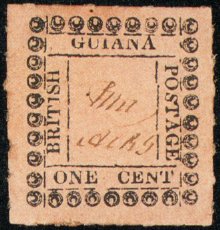



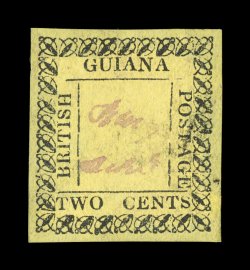



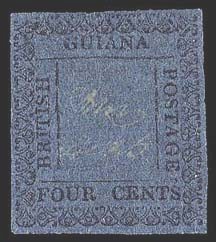
(The above stamps are genuine stamps)
1 c black on lilac 2 c black on yellow 4 c black on blue
There are 3 different borders for the 1 c and 2 c ("crossed ovals" 12 stamps in a sheet of 24; "pearls" 8 stamps and "grapes" 4 stamps). Another 3 different borders exist for the 4 c ("hearts and pearls, 10 stamps in a sheet of 24, "cross in rosace, with inner lines", 2 stamps; subtype "cross in rosace, without inner lines" 6 stamps and "trefoil" 6 stamps). They were all printed in sheets of 24 stamps (4 rows of 6), resulting in 24 varieties. The 2 c was printed by removing the value "ONE CENT" and replacing it by "TWO CENTS". There must be a signature of the postmaster 'R.M. As. R.G.' (Robert Mather Assistant Receiver General) on it. The signature is black on the 1 c, red on the 2 c and white (actually due to decoloration of the paper) on the blue stamps. Furthermore many forgeries exist (some of them already produced in the 1870's, by the way, I'm not sure if the above stamps are all genuine). An article describing the types of this issue can be found in the Philatelic Record of 1881-1882 (page 108) by F.A.Philbrick. All the subtypes are described here. Already back in 1882, 1 out of 20 stamps only was genuine....


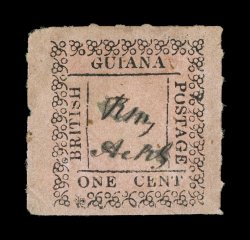
The main types of the 1 and 2 c: Ovals, Pearls and Grapes types
(all genuine)




The main types of the 4 c: Hearts and pearls, Cross in rosace
types (with inner lines), Cross in rosace types (without inner
lines) and the trefoil type (this type has no inner lines).
For British Guiana 1862, provisional issue, subtypes, click here.
Value of the stamps |
|||
vc = very common c = common * = not so common ** = uncommon |
*** = very uncommon R = rare RR = very rare RRR = extremely rare |
||
| Value | Unused | Used | Remarks |
| 1 c | RRR | RRR | |
| 2 c | RRR | RRR | |
| 4 c | RRR | RRR | |
Images of a whole sheet of 1 c and 4 c stamps can be found in Die Ferrary Auktionen (II Auktion, plate 8).
Remainders of the 1 c exist with no signature and no perforation.



Remainders of the 1 c; always without perforation (normal stamps
were rouletted).
For Types and Subtypes, click here.
Forgeries, examples:
The images show the stamps as they appears in the Moens catalogue ('Les Timbres-Poste Illustres' by J.-B.Moens 1864) are shown first and then are shown forgeries based on this Moens catalogue (either by Moens himself or someone who based himself on this catalogue):

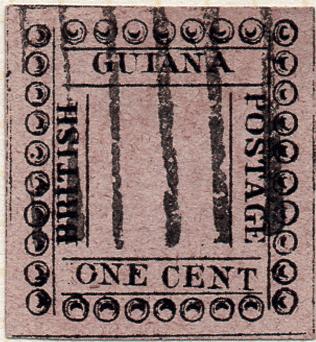





The 4 cents value did not have a pearl border type. The other
values were apparently made by the same forger. Some of the
forgeries have an outer frameline (as it appears in the Moens
catalogue, but not on the genuine stamps). I've seen a 4 c of
this forgery in a Fournier Album. The 5th pearl from the top on
the left hand side has a dot in it (which does not appear on the
original Moens image!). These forgeries are mentioned in Album
Weeds. Note the low "T" in the "ONE CENT"
value. The 2 c with signature and convincing cancel is rather
deceptive.




Another Moens forgery: The crossed oval border only appeared on
the 1 c and 2 c values, never on the 4 c as in the above forgery.
For the 1 c and 2 c, this forgery does not correspond to any of
the genuine subtypes. Also, the
signature is missing or is wrong.



Another Moens forgery; the cancel might have been applied by Fournier. I've also seen the 4 c value
of this particular forgery. Note the typical position of the
grapes in the corners.

Fournier forgeries and forged 'A03'
cancel (images taken from a 'Fournier Album', reduced sizes).
Note that the '3' of the 'A03' cancel has a flat top.
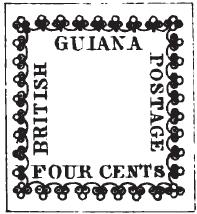





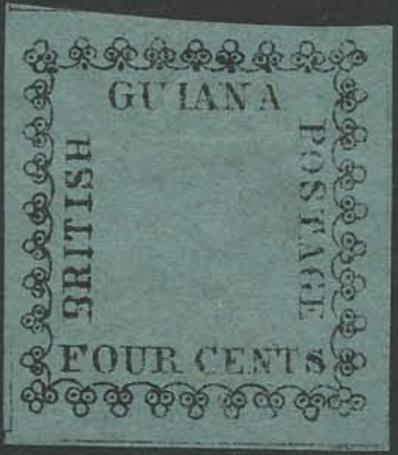

Moens forgery as it appears in his stamps catalogue of 1864. Next
to it a forgery from a Fournier Album
of Philatelic Forgeries of the 1 c value, differing from the
above forgery. This stamp has a trefoil frame, which was never
used for the 1 c value (it was only used on the 4 c). Next to it
a 2 c forgery, made by the same forger. The 4 c forgeries have
the trefoil pattern, but it doesn't resemble a genuine pattern.
Also note the small "S" in "CENTS". And a
stamp from the Fournier Album of Philatelic Forgeries (with
"FAUX" overprint)

Moens forgery as it appears in his stamps catalogue of 1864. In
the Ragatz book on Fournier forgeries, a 1 c of this type is
shown with a "A03" Fournier cancel. Note the spaces
between the last upper right ornament and the others and other
small spaces between the ornaments.

Fournier forgery of the 1 c based on the above Moens forgery.

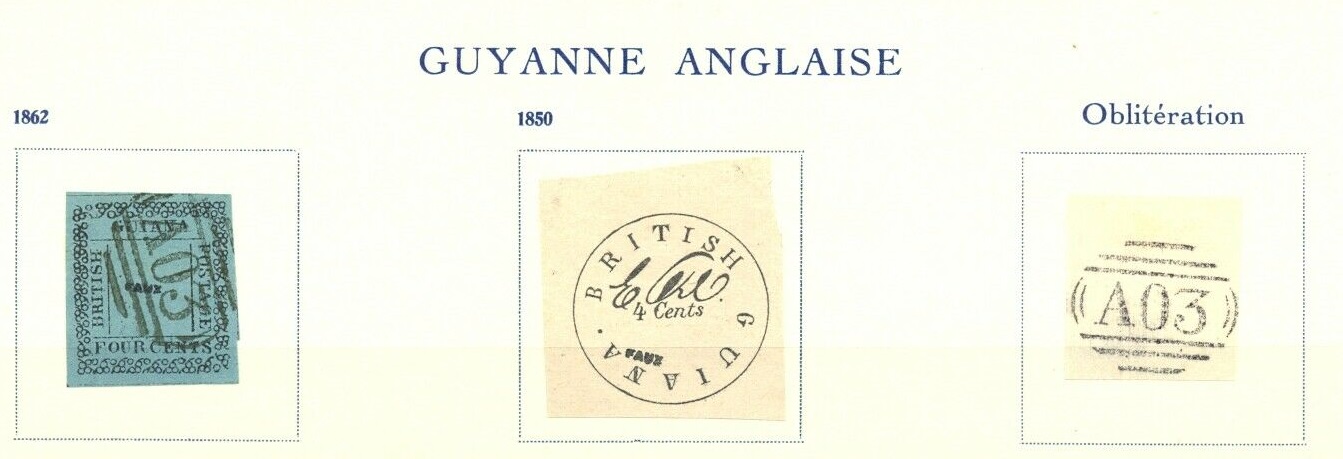
Other cuts from a Fournier Album.

Other example from a Fournier Album.

Left: bogus design with flowers in the corners that appeared in
the Moens catalogue in 1864 ('Les
Timbres-Poste Illustres' by J.-B.Moens 1864, plate 54).






Forgeries based on the above Moens bogus design. The corner
designs should not have flowers as in the above forgeries. The
signature in the center also does not resemble the genuine
signature. There are at least two different types of the 4 c (as
shown above, note for example the position of the "T"
of "CENTS"). There shouldn't be any outer guidelines in
the stamps. The 1 c has a 'Fournier' cancel.

Same forgery as above,1 c value, reduced size. All stamps with
manual inscription 'Nor Bor' are forgeries (source:
http://www.stampboards.com/viewtopic.php?f=10&t=19438&view=next)

Another forgery of the 4 c value. It looks very much like the
illustration that appeared on the right hand side of Moens shown
above.


The crossed oval border only appeared on the 1 c and 2 c values,
never on the 4 c as in the above forgeries. Also, the signature
is missing. The cancel (parallel bars) looks bogus to me.

The lettering is very badly done in this forgery. The ornaments
are quite different from any genuine pattern. This forgery has an
outer frameline.

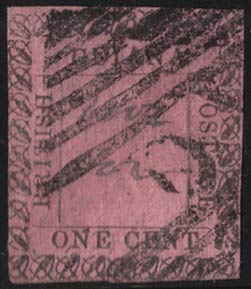


Some 'Nor Bor' forgeries. The ovals at the right hand side are
all pointing downwards towards the left. No genuine type has such
an arrangement. The cancel applied to these forgeries appears to
be some square consisting of lines with numbers 'A03'? in the
center. Some of the above forgeries have the ornament next to the
"ST" of "POSTAGE" different from the other
ornaments.


Rather deceptive forgery, the oval next to the "ST" of
"POSTAGE" is quite different from the rest. This is
probably the second forgery of Type II of Album Weeds.



Some other 'Nor Bor' forgeries.

Extract from Bazaar Exchange and Mart Vol. 64, 1892, indicating
that this forgery type was already well known in 1892: "where
you see a British Guiana provisional with the words "nor
bor" written on it, you may put it aside as a forgery
without further examination."
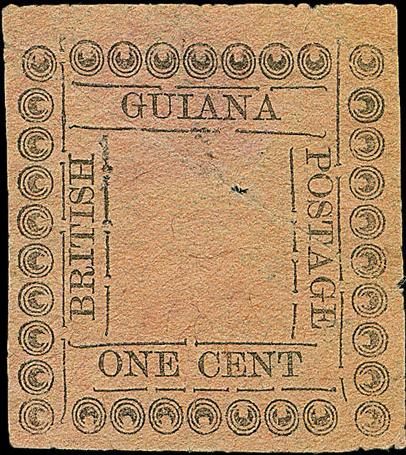






Some badly done forgeries. In my opinion, in the left hand
pattern, the halfmoons in the pearls are pointing to the right,
in the genuine stamps, they point to the right. The last forgery
was found in the Fournier Album of Philatelic Forgeries. Note the
inscription "ONE CENTS" in some of the above forgeries.



I presume that these are two more deceptive forgeries of the 2 c
value. Note the strange signature in the center. The third stamp
was offered on a Sandafayre auction as being genuine though....

The 'hearts and pearls' border was never used for the 2 c
value....

Forgery with the text too large.


Some forged minisheets (reduced sizes). Genuine stamps were
printed in sheets of 24.